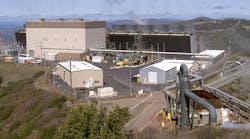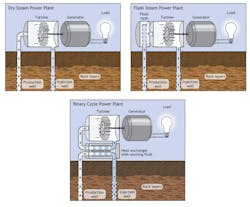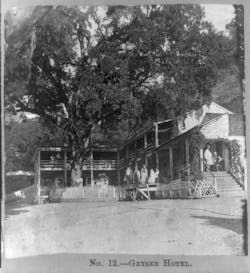The World’s Largest Geothermal Field: 22 Power Plants, More Than 350 Wells
When it comes to tapping geothermal energy for electricity production, the Philippines, Indonesia, Mexico, New Zealand, Italy, Iceland, Turkey and the U.S. have 84% of the world’s geothermal generating capacity. Out of those respective countries, the U.S. bills the top spot on the electrical marquee, producing 3,567 MW of geothermal power with another 1,270 MW of additional projects currently in development, according to a fact sheet from the University of Michigan.
Geothermal power is considered a sustainable, renewable source of energy, as the heat extraction is negligible when compared to the Earth’s internal heat budget—estimated at 47 terawatts and derived from radioactive decay and primordial heat left over from the planet’s formation. In order to tap into this thermal energy, heat must be carried to the relative surface through fluid circulation through any number of taps, including magma chambers, hot springs, drilled wells, and hydrothermal transmission.
Three types of geothermal power plants, including Dry Steam, Fresh Steam, and Binary Cycle. (Image credit: DOE)
Processing geothermal energy is done in the same manner as other steam turbine power plants, only instead of using a myriad of different fuel sources to generate steam, geothermal plants rely on the steam generated from already heated water (or other working fluid) by the Earth’s core itself.
Processing that steam energy is done through several methods: Dry Steam, which uses direct steam to turn the plant’s turbines; Flash Steam, which uses steam derived from high-pressure water to turn the turbines; and Binary Cycle, a process that uses hot geothermal water passed by another fluid with a low boiling point, which flash vaporizes—turning into steam to drive the turbines.
This brings us to the question of which is the largest geothermal power plant in terms of power capacity. The short answer, in this case, is not just a single plant, but rather a massive complex with 22 plants that draw steam from over 350 wells, producing a combined 1,517 megawatts of power.
The Geysers Complex is located roughly 72 miles north of San Francisco in California’s Mayacamas Mountains and sits on the world’s largest geothermal field. Spanning approximately 30 square miles, it houses a magma chamber that’s four miles deep beneath the surface and greater than eight miles in diameter.
The Geysers Complex began as The Geysers Resort back in the mid-1880s, with the first geothermal power plant going online decades later in 1921. (Image credit: Andrew Price)
The Geysers Complex actually began as The Geysers Resort in the mid-1880s and was marketed as a spa to attract guests, which started to fall in popularity by the turn of the century. In 1921, the owner of the resort developed the first power plant at the location, which produced 250 kilowatts and powered the lights of the resort.
More Dry Steam plants were built over the ensuing years, and by the next turn of the century (1999), power production began to deplete as the Geysers’ steam field began to run dry. As a result, plant owners began “recharging” the field by injecting effluent-treated sewage directly into the geothermal area.
As strange as that might sound, liquid waste was responsible for producing 77 megawatts of power in 2004 alone, and continues to provide recharges when necessary. The effluent itself is piped up to the field from its source at the Lake County Sanitation wastewater treatment plants located more than 50 miles away.
Four of those water treatment plants that handle waste from 10 different communities are diverted to the Geysers geothermal field, which not only increases the power that can be generated but also protects the local waterways, lakes and other surface waters from becoming polluted.
On the downside, injection of that effluent water has a tendency to cause some minor seismic activity, with the average being a magnitude 3.0 on the Richter scale. Of course, most plants were designed to handle the earthquakes, and the location itself doesn’t rest near any major fault lines, making any local impact negligible.
Of the nearly two-dozen geothermal power plants located at the Geysers, 15 are owned by Calpine Corporation, with the others owned by the Northern California Power Agency and Santa Clara’s Electric Utility (among others). Altogether, they providing 1,517 megawatts of electricity to California’s Sonoma, Mendocino, and Lake Counties, and will continue to do so for years to come.



